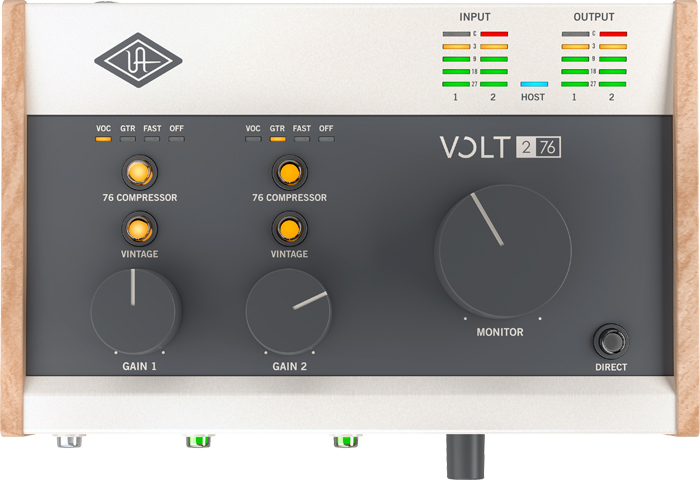|
|
Universal Audio Volt Interfaces
|
|
|
 |
| Universal Audio Volt Interfaces |
There are five new Universal Audio Volt USB audio interfaces ranging in price from $139 to $369. All five are USB 2.0 class-compliant interfaces for Mac/PC/iPad/iPhone devices with 24-bit/192 kHz audio converters. All come with professional XLR Combo input jacks, switchable +48-volt phantom mic powering with selectable Instrument inputs and a vintage mic pre-amp mode said to sound like Universal Audio's 610 Tube mic pre-amp. There is a switchable 76 Compressor mode that uses an onboard analog preset compressor based on the UA's 1176LN Peak Limiter.
All the interfaces have headphone jacks with volume controls and all have rear panel MIDI DIN connectors, an USB C jack, and a jack for an external 5-volt power supply if your portable device is low on power. I liked that there is a "host" LED amongst the Input and Output level meters to show you're connected.
The five Universal Audio Interfaces are: the Volt 1 at $139 MSRP with a single mic input and stereo outs, a great basic unit for bloggers and Zoom meetings; the Volt 2 at $189 MSRP is the same but with two inputs for recording in stereo.
Next is the Volt 176 at $249 MSRP and includes the 76-compressor mode but is the same otherwise, while Volt 276 at $299 MSRP (my review unit) is the same except it has two mic inputs. Things get more serious with the Volt 476 at $369 MSRP; a complete four-channel interface with multi-channel input/output metering, headphone monitoring and switchable line level inputs.
I hooked up my Volt 276 in place of another USB interface and it worked immediately and perfectly. Compared to my previous interface, the Volt interfaces are more practical to hook up while sitting on my desktop. I liked the front mounted XLR Combo jacks for plugging in mics, direct guitars or keyboards while the rear mounted jacks easily connect to powered speakers, computer and MIDI.
I tried my professsional Soundelux/Bock Audio U195 condenser mic on a vocal session--I switched on the 48-volt phantom power for it and it sounded great. You have a choice between listening to yourself in Direct mode or through your connected DAW's mixer. I used Pro Tools with a buffer size of 32 samples. Direct mode is useful when using much higher buffer sizes so you'll hear yourself without delay or latency. For monitoring, I use my Hi-X65 Austrian Audio headphones and had plenty of volume.
Volt 276's mic pre-amp has about 55dB of mic gain and that is fine for most microphones. Some dynamics like a Shure SM-7, Shure MV-7 or a Royer 121 ribbon mic may require an in-line amplifier like Royer's dBooster to get full level on very quiet sounds so I would suggest always using condenser mics that generally have a higher output level. Without the dBooster, my Shure MV7 podcasting mic required the mic gain all the way up and it sounded fine.
I tried Vintage mode and it does add a warm thickness to whatever you are recording. Using Vintage and 76 has become standard operating procedure around here--76 has presets for voice, guitar, synths and drum machines. It is not necessarily a big squashed sound at all--it just keeps recording levels more consistent and worked well for my singer. You can always add more compression in your mix! I found the input and output LED meters are easy to see from across the room.
I think the new Volt interfaces are all great values especially considering all the software that comes with them--just download products from: Ableton, Celemony, Plugin Alliance, Relab, Softube, Spitfire and UJam--all free. Also available are various studio packs with Volt-badged microphone and headphone combinations. The studio packs are an awesome way to get going right now!
www.uaudio.com/audio-interfaces/volt.html
|
|
|